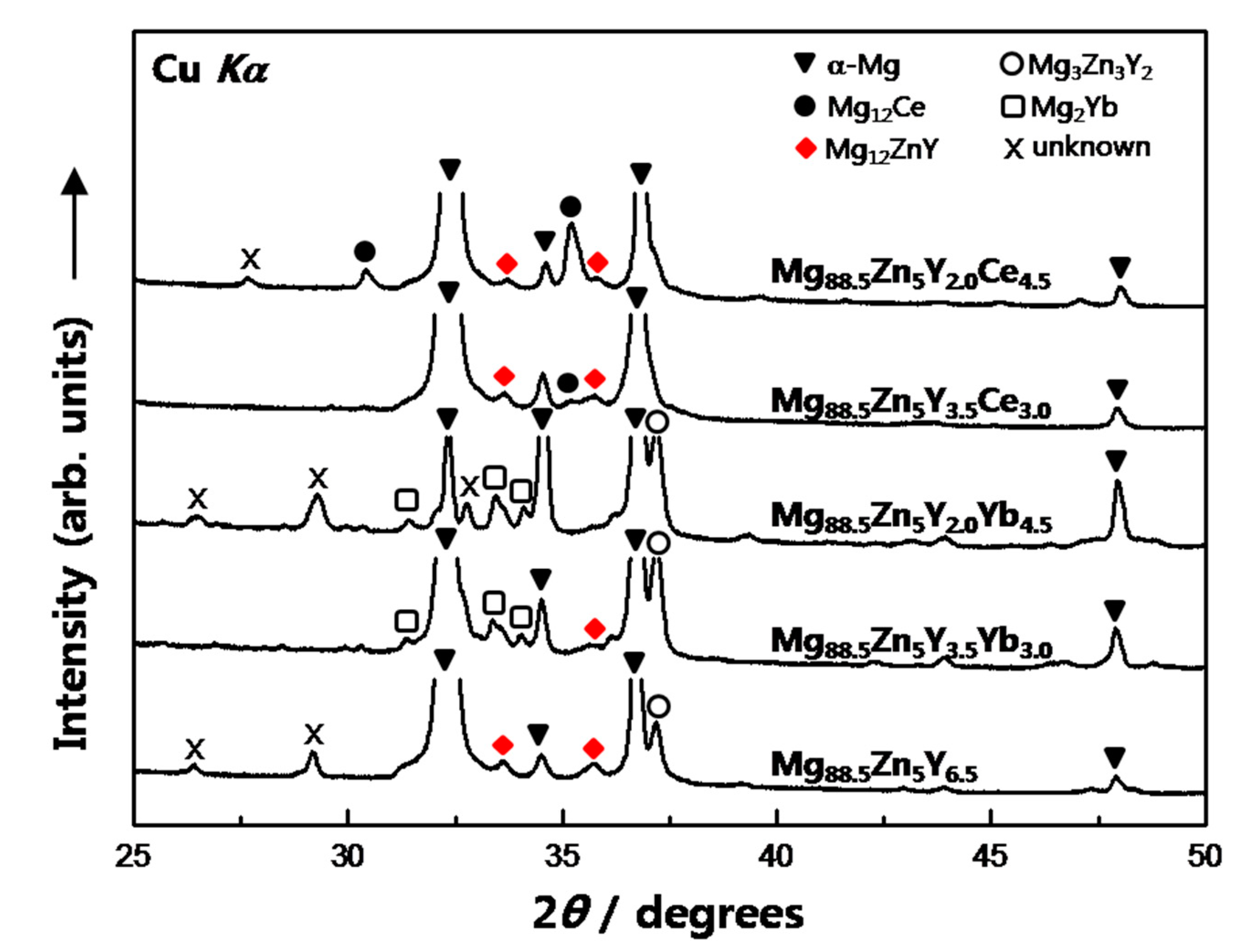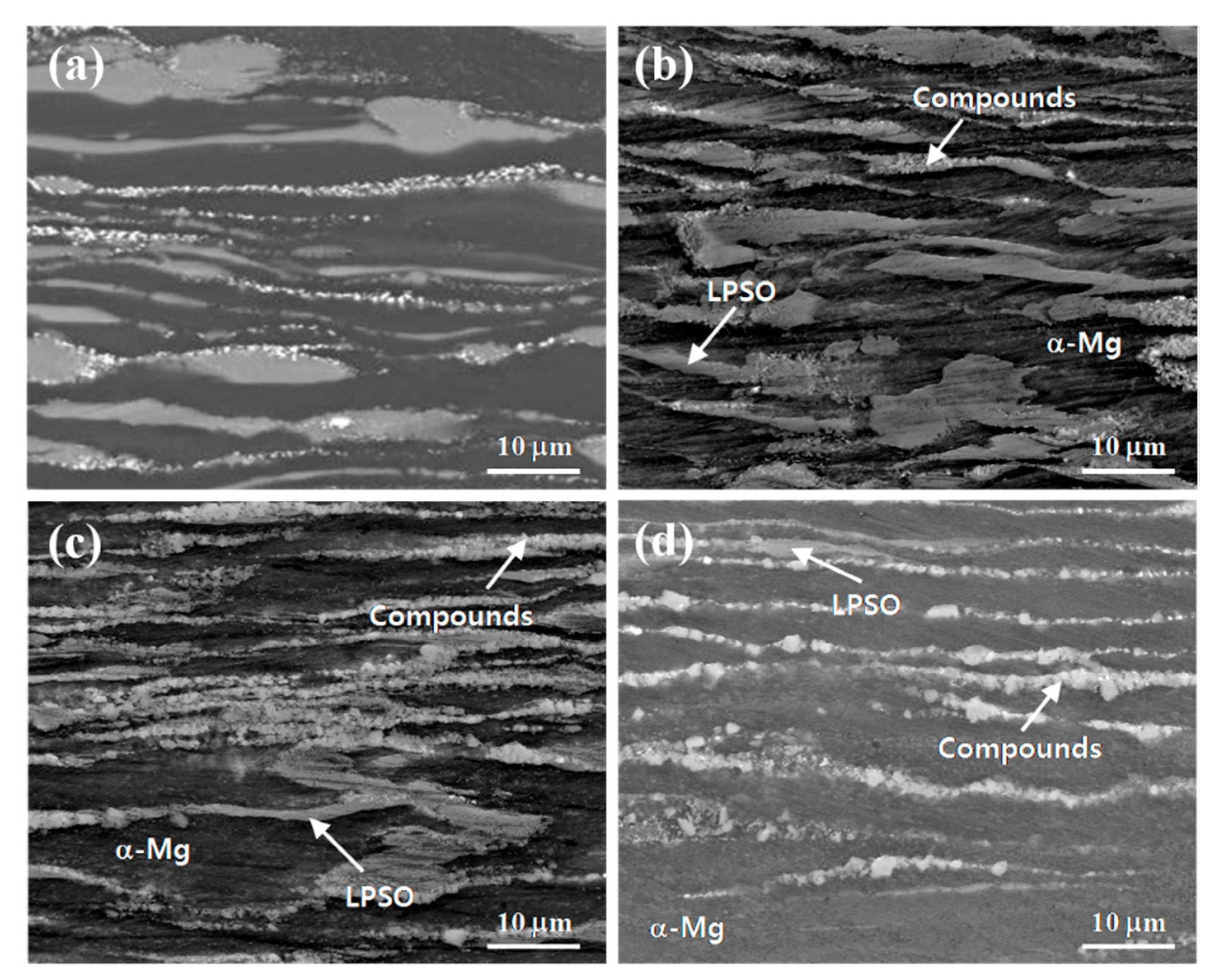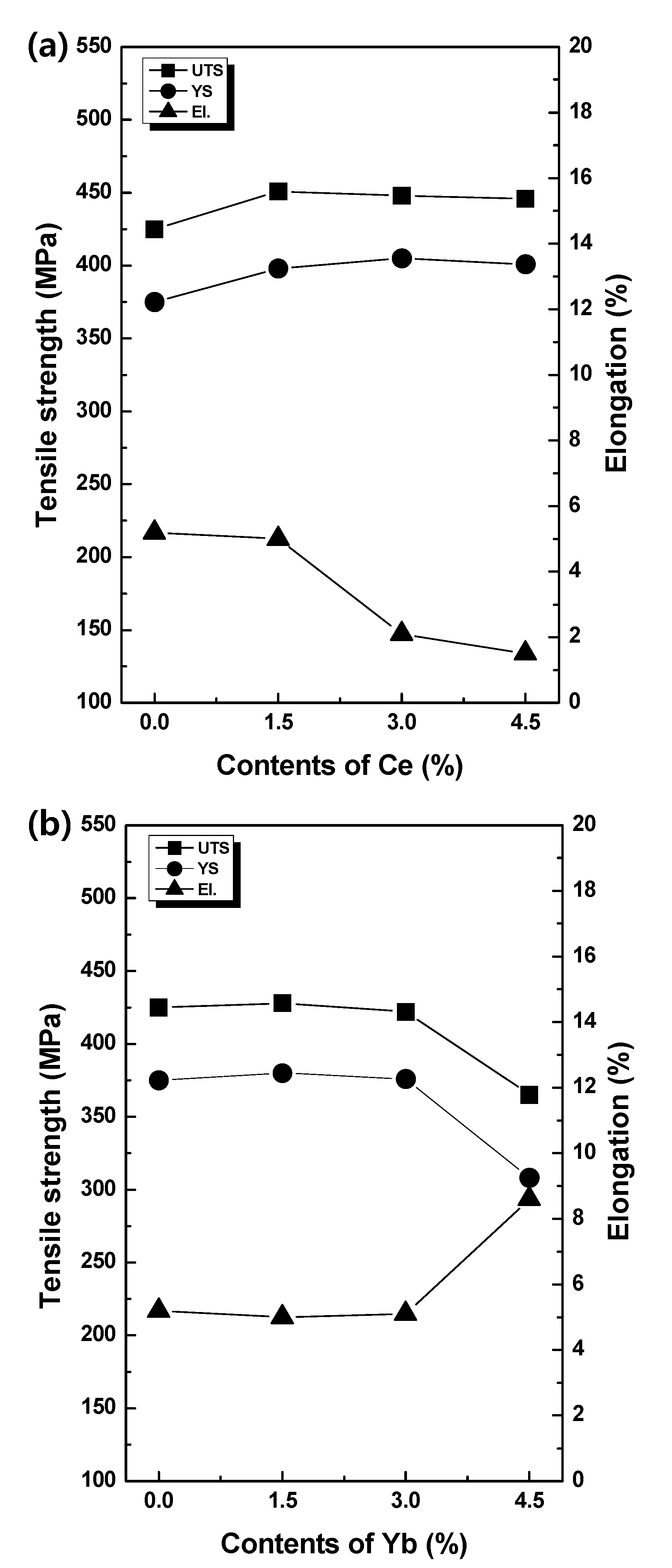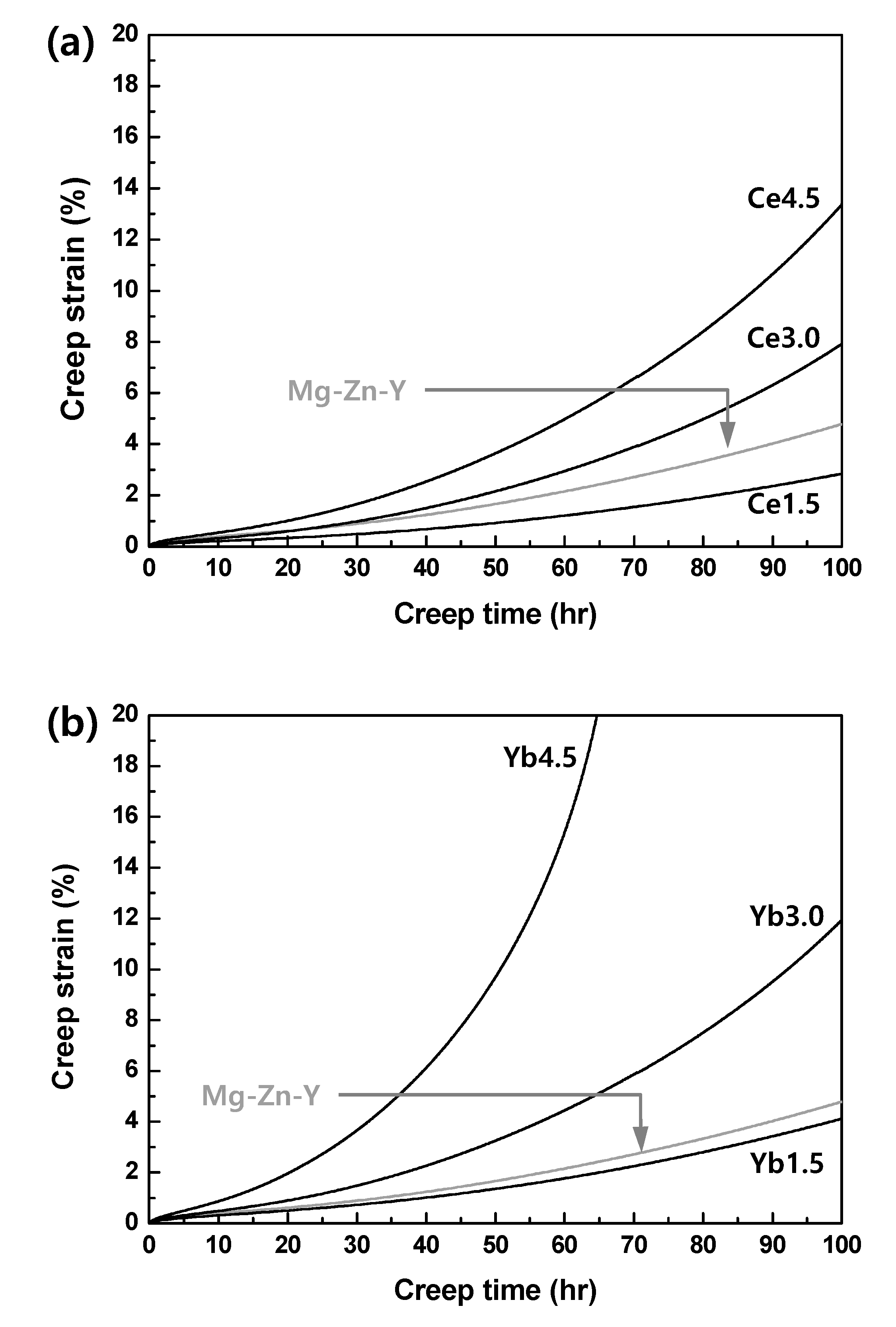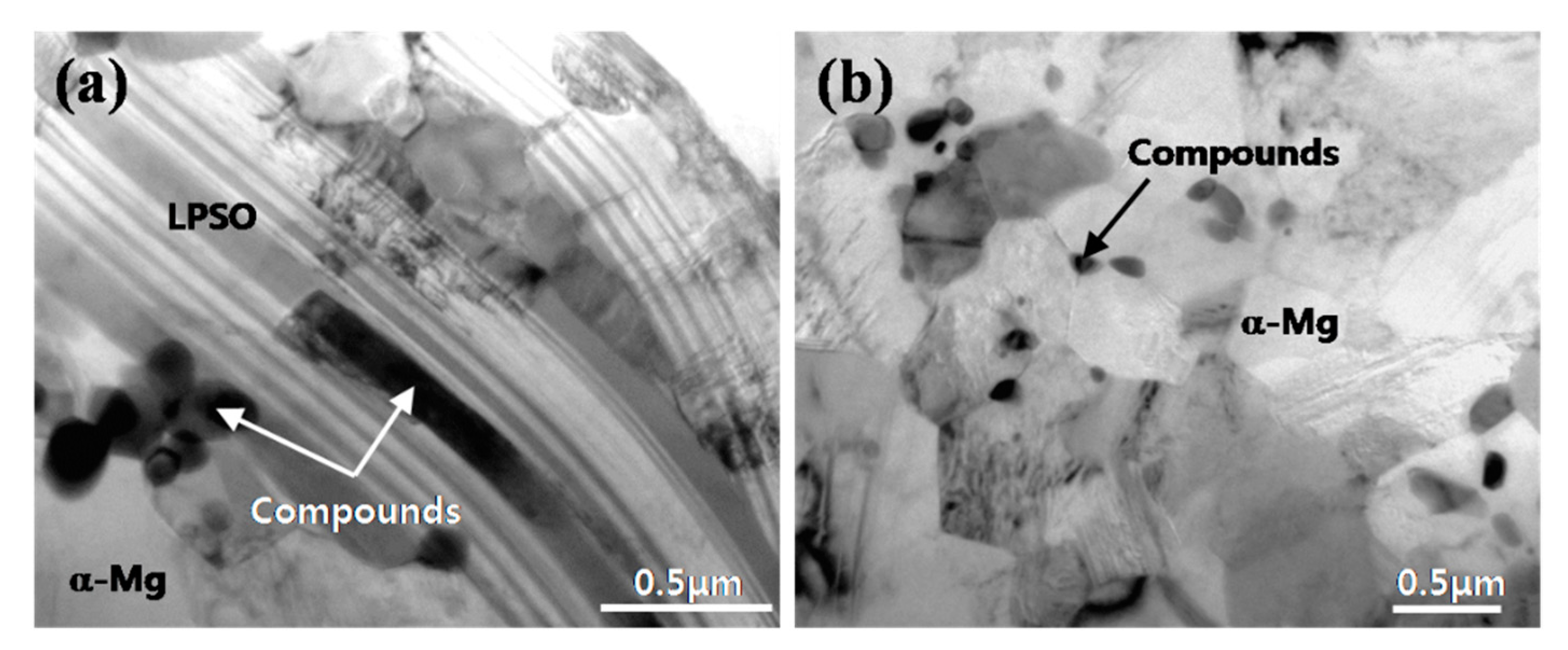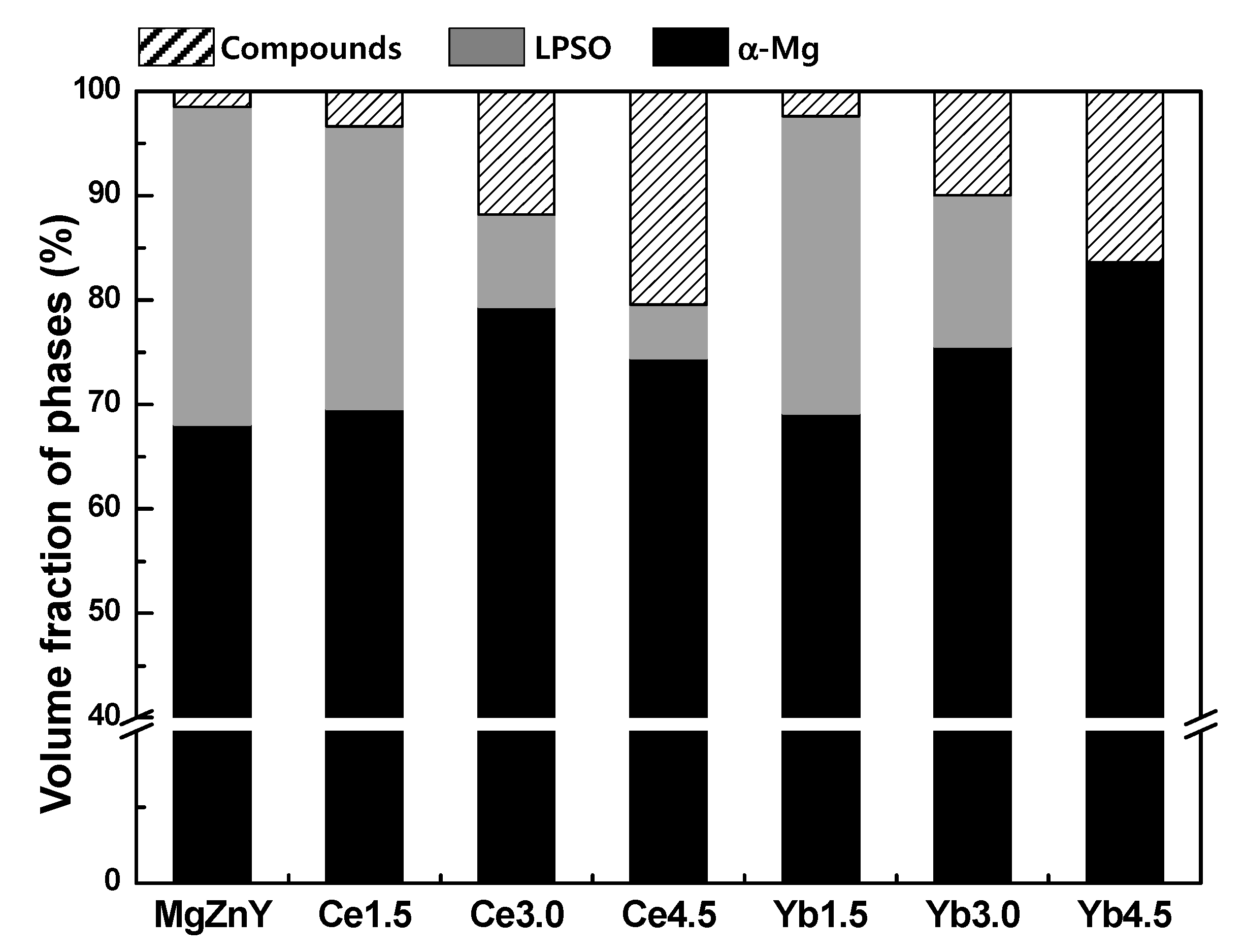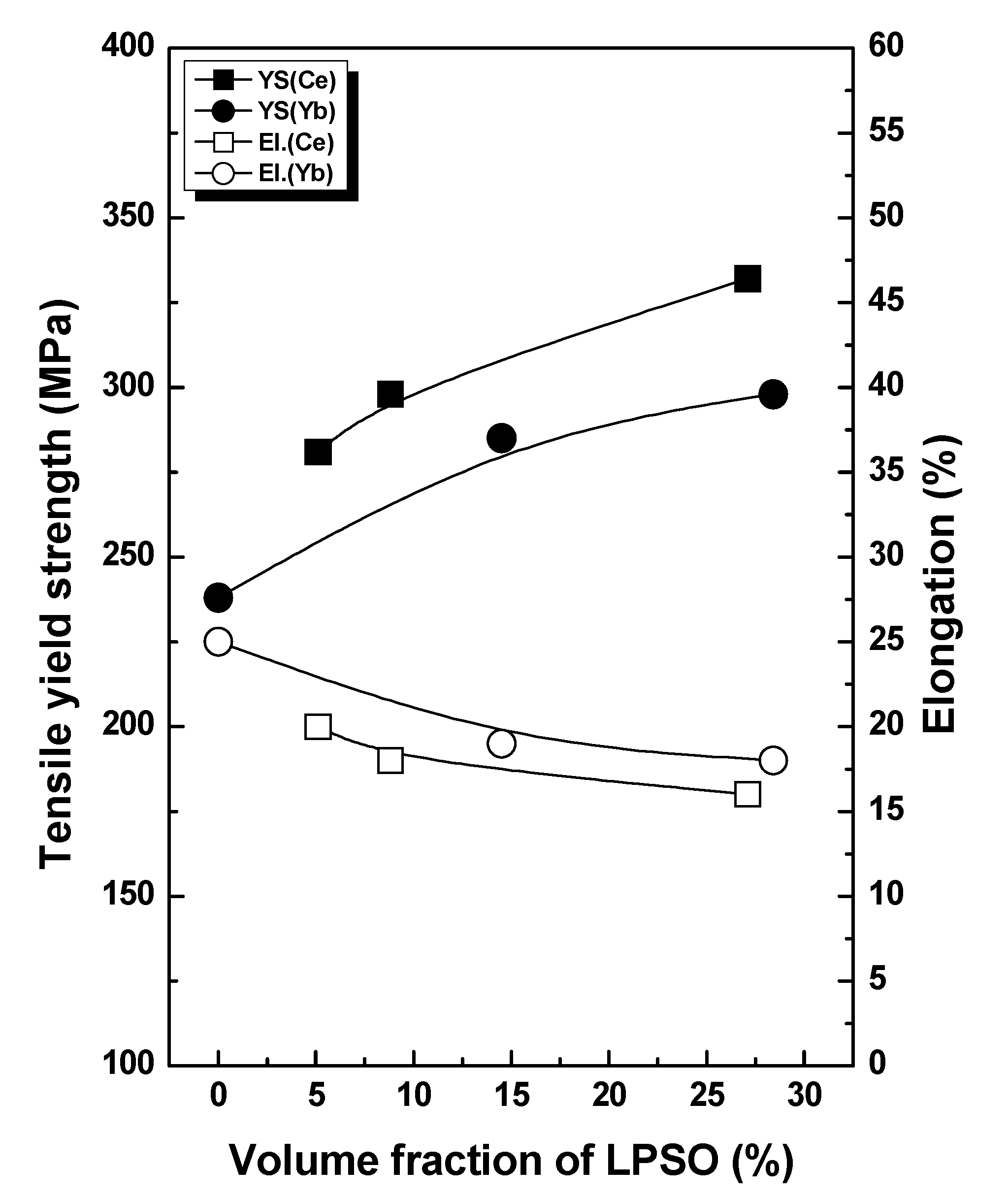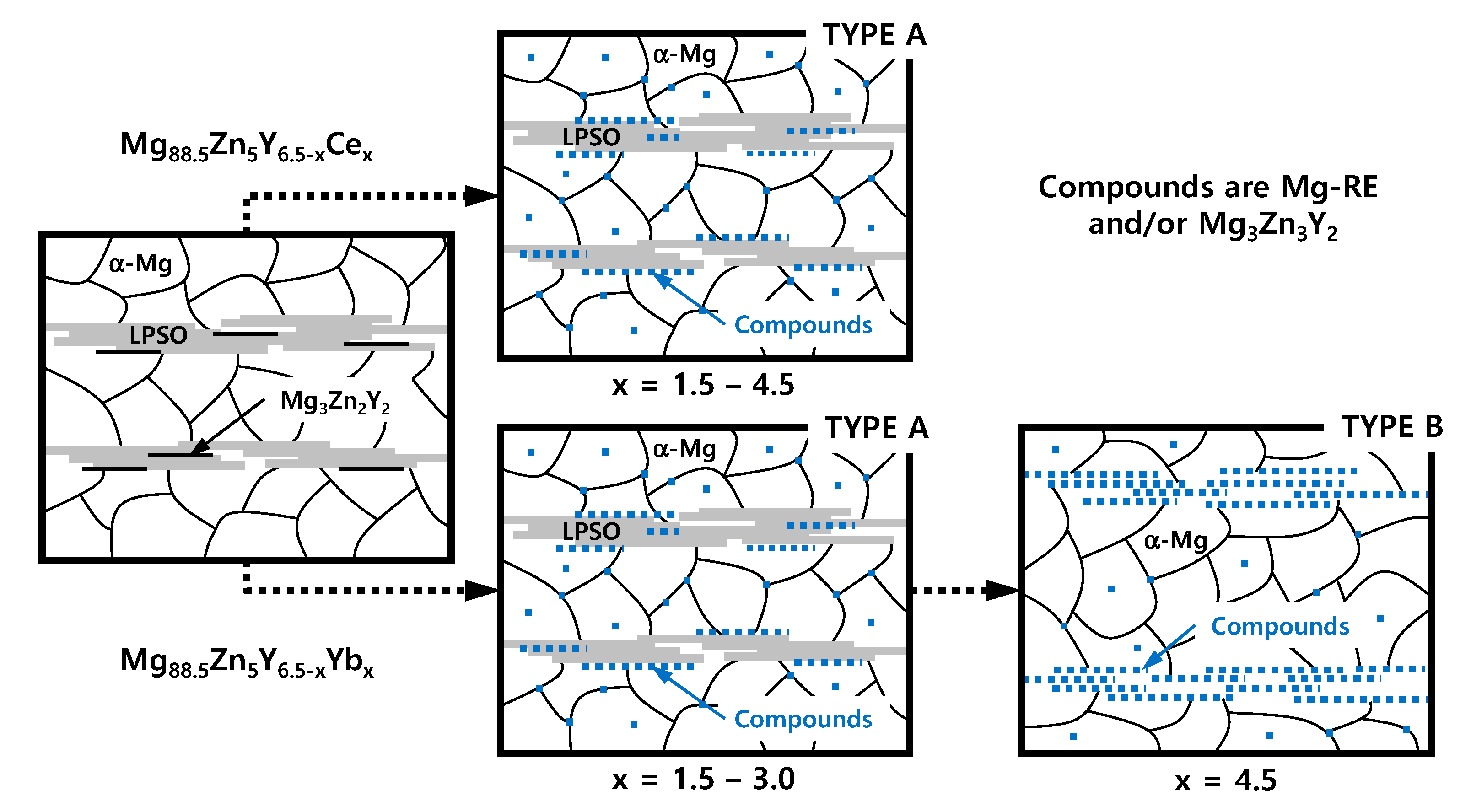3. Results
Figure 1 shows the XRD patterns of the Mg
88.5Zn
5Y
6.5-XRE
X alloys. Mg
88.5Zn
5Y
6.5 comprised α-Mg, Mg
12ZnY (LPSO phase), and Mg
3Zn
3Y
2 (intermetallic compound). The intensity of the peaks of the LPSO phases decreased with the increase in the content of Yb and Ce. The peaks of the LPSO phases were absent in the XRD pattern of Mg
88.5Zn
5Y
2.0Yb
4.5. The primary second phases in Mg
88.5Zn
5Y
3.5Yb
3.0 and Mg
88.5Zn
5Y
2.0Yb
4.5 were Mg
2Yb and Mg
3Zn
3Y
2. The intensity of the peak of Mg
2Yb increased with the increase in the Yb content. The substitution of Y with Ce induced the disappearance of the peaks of Mg
3Zn
3Y
2 and the appearance of the peaks of Mg
12Ce. The intensity of the peaks of Mg
12Ce increased with the increase in the Ce content.
Figure 2 and
Figure 3 show the SEM micrographs of the as-cast Mg
88.5Zn
5Y
6.5-XRE
X alloys. The light and dark gray phases denote the LPSO phases and intermetallic compounds (marked by an arrow), respectively. A coarse dendritic structure was formed by the continuous network of the LPSO phases and intermetallic compounds. The volume fraction of the LPSO phases decreased significantly with the increase in the Yb and Ce content. The LPSO phases were not detected in Mg
88.5Zn
5Y
2.0Yb
4.5, and this result was consistent with the XRD analysis. The XRD data indicated that the Mg
3Zn
3Y
2 phases constituted the compounds in Mg
88.5Zn
5Y
6.5. The Mg
2Yb phases were the primary constituents of the compounds in the Mg-Zn-Y-Yb alloys, while the Mg
3Zn
3Y
2 and Mg
12Ce phases were the primarily constituents of the compounds in the Mg-Zn-Y-Ce alloys.
Figure 4 and
Figure 5 show the SEM micrographs of the extruded alloys along the extrusion direction. Although the volume fractions of the LPSO phases and intermetallic compounds remained unchanged, there was a significant variation in the morphology. The LPSO phases exhibited a transformation from a net-like to rod-like morphology, and they were uniformly distributed along the extrusion direction in all the samples. The compounds exhibited a morphological transformation from bulk to granular (particles) during extrusion. Furthermore, only the particles of Mg
2Yb were detected in Mg
88.5Zn
5Y
2.0Yb
4.5. These observations were consistent for the XRD and SEM analyses of the as-cast alloys.
The mechanical properties of the extruded alloys at room temperature and 200 °C are presented in
Figure 6 and
Figure 7, respectively. Mg
3Zn
3Y
2 exhibited a TYS, UTS, and elongation of approximately 375 MPa, 425 MPa, and 5.2%, respectively. There was an initial increase and a subsequent decrease in the mechanical strength with the increase in the Yb and Ce content. This indicated that the substitution of Y with an optimal concentration of Yb and Ce increased the strength of the alloys. Mg
88.5Zn
5Y
5.0Ce
1.5 exhibited the highest strength, while Mg
88.5Zn
5Y
2.0Yb
4.5 exhibited the lowest strength and the highest elongation. The strength and elongation at 200 °C were significantly lower and higher, respectively, than those at room temperature. Mg
88.5Zn
5Y
5.0Ce
1.5 exhibited the maximum strength at 200 °C with a TYS and UTS of 330 MPa and 360 MPa, respectively. It was observed that Mg
88.5Zn
5Y
5.0Ce
1.5 exhibited the highest strength at both room temperature and 200 °C.
The creep curves for the extruded alloys were obtained at 200 °C and 150 MPa and are presented in
Figure 8. The curves depicted the first and second stages of creep deformation [
20]. The effects of Yb and Ce on the creep rate of Mg
88.5Zn
5Y
6.5 were discernible from the figure. There was an initial increase and a subsequent decrease in the creep resistance of the Mg-Zn-Y-RE alloys with the increase in the Yb and Ce content. The creep resistances of only Mg
88.5Zn
5Y
5.0Ce
1.5 and Mg
88.5Zn
5Y
5.0Yb
1.5 were higher than the creep resistance of Mg
88.5Zn
5Y
6.5. It was concluded that the creep resistance of the Mg-Zn-Y-Ce alloys was higher than that of the Mg-Zn-Y-Yb alloys.
The mechanical properties and creep resistance of Mg
88.5Zn
5Y
5.0Ce
1.5 were superior to those of the other alloys. EBSD analyses were performed to compare the crystallographic features of the extruded Mg
88.5Zn
5Y
6.5 and Mg
88.5Zn
5Y
5.0Ce
1.5, and the results are presented in
Figure 9a,b. The color variation denotes the grain orientation, and the black grains denote the LPSO phases. A part of the worked α-Mg region, with coarse grains, and the dynamically recrystallized (DRXed) α-Mg region, with fine grains, existed in Mg
88.5Zn
5Y
6.5 and Mg
88.5Zn
5Y
5.0Ce
1.5. Mg
88.5Zn
5Y
6.5 and Mg
88.5Zn
5Y
5.0Ce
1.5 exhibited an increase in the grain size after heat treatment at 400 °C for 1 h. Furthermore, the heat treatment induced static recrystallization in Mg
88.5Zn
5Y
6.5 and Mg
88.5Zn
5Y
5.0Ce
1.5, thereby resulting in the transformation of all the worked α-Mg grains to recrystallized grains [
21]. Therefore, no worked α-Mg regions were detected in the heat-treated alloys, and the microstructure became uniform. The grains in Mg
88.5Zn
5Y
5.0Ce
1.5 were finer than those in Mg
88.5Zn
5Y
6.5, for both the as-extruded and heat-treated states [
22].
Figure 10 shows the TEM micrographs of the extruded Mg
88.5Zn
5Y
5.0Ce
1.5. Mg
88.5Zn
5Y
5.0Ce
1.5 primarily comprised α-Mg grains, intermetallic compounds, and LPSO phases. The rod-like LPSO phases were distributed within the grains (
Figure 10a). Furthermore, two types of compounds were detected in the alloy; one was distributed in the form of particles at the grain boundaries, while the other existed as blocks within the α-Mg matrix and between the LPSO phases.
4. Discussion
Figure 11 shows the calculated volume fractions of α-Mg, the LPSO phases, and intermetallic compounds in the Mg-Zn-Y-RE alloys. MgZn
5Y
6.5 comprised 31.5 and 2.8 vol.% of the LPSO phases and intermetallic compounds, respectively. The content of the LPSO phases decreased from 24.4 to 5.2% with the increase in the Ce content from 1.5 to 4.5%. The addition of Yb also decreased the content of the LPSO phases, and no LPSO phases were detected in MgZn
5Y
2.0Yb
4.5. The criteria for the formation of LPSO phases in the Mg-Zn-RE alloys are as follows [
23]:
High solid solubility limit in Mg alloys.
Negative mixing enthalpy between Mg-RE and Zn-RE.
HCP structure at room temperature.
Higher atomic size of the RE atoms as compared to that of Mg.
The negative mixing enthalpy between Mg-RE and Zn-RE as well as the difference in the atomic sizes of Mg, Zn, and RE were similar for the addition of Ce and Yb. However, the solid solubility limits of Ce and Yb in magnesium are 0.66 and 3.3 wt.%, respectively, at the eutectic temperature [
14]. The high solid solubility limit of Yb lowered the volume fraction of the intermetallic compounds in the Mg-Zn-Y-Yb alloy; however, the effect on the volume fraction of the LPSO phases was negligible at a Yb content of 1.5 and 3.0 wt.%. Therefore, the volume fraction of the LPSO phases in the Mg-Zn-Y-Yb alloys was higher than that of the LPSO phases in the Mg-Zn-Y-Ce alloys. The LPSO phases were absent in Mg
88.5Zn
5Y
2.0Yb
4.5. The XRD analysis indicated that Zn and Y formed a compound, Mg
3Zn
3Y
2, instead of the LPSO phases. The underlying reason for this phenomenon needs further research.
According to the IPF maps (
Figure 9), the average grain size of both the Mg
88.5Zn
5Y
6.5 and Mg
88.5Zn
5Y
5.0Ce
1.5 alloys is 1.5 μm. In fact, the average grain size of all the alloys is almost same, and this result excluded the effect of grain size on the strength, so the major factor to effect of mechanical properties is the second phases. Mg
88.5Zn
5Y
5.0Yb
1.5 and Mg
88.5Zn
5Y
5.0Ce
1.5 possessed a networked and stratified structure of LPSO phases and intermetallic compounds (
Figure 4 and
Figure 5). This structure was responsible for the high strength of these alloys. The mechanical strengths of Mg
88.5Zn
5Y
5.0Yb
1.5 and Mg
88.5Zn
5Y
5.0Ce
1.5 were higher than the mechanical strength of MgZn
5Y
6.5 at both room temperature and 200 °C. A curve of the variation in the tensile yield strength with the volume fraction of the LPSO phases was plotted (
Figure 12) to elucidate the effect of the Yb and Ce content on the mechanical properties of Mg-Zn-Y-RE alloys. There was a marked increase in the TYS, with the increase in the content of the LPSO phase. The LPSO phases exhibit a unique mode of plastic deformation, known as kink deformation [
24]. The deformation models of the LPSO phases and α-Mg are significantly different. Therefore, the deformation of the LPSO phases in the grains is incompatible with that of α-Mg. Consequently, the alloys containing the LPSO phases exhibit high strength [
25]. Multiple researchers have reported that alloys containing the LPSO phases exhibit an extremely high strength [
26,
27]. The variation in the mechanical properties was primarily attributed to the volume fraction of the LPSO phases.
As shown in
Figure 9, the worked Mg grains that existed in the Mg
88.5Zn
5Y
5Ce
1.5 and Mg
88.5Zn
5Y
6.5 alloys disappeared after the heat treatment at 400 °C for 1 h. This result indicated the presence of deformed storage energy inside the grains after extrusion. The heat treatment enabled the deformed storage energy to become the driving force for recrystallization nucleation. This induced the transformation of the worked Mg grains to recrystallized grains through a particulate-stimulated nucleation mechanism. The high-volume fraction of LPSO phases results in a significant stress transferred from the Mg matrix to the LPSO phases, which is much higher than the compounds [
28]. Therefore, the Mg
88.5Zn
5Y
5Ce
1.5 alloy with low LPSO phases have much more strain energy to induce recrystallization than the MgZn
5Y
6.5 alloy, and leads to a finer grain size after heat treatment. The thermal stability of Mg
88.5Zn
5Y
5.0Ce
1.5 was higher than that of Mg
88.5Zn
5Y
6.5 at high temperature, and Mg
88.5Zn
5Y
5.0Ce
1.5 exhibited a high strength and creep resistance at 200 °C. The creep resistance of Mg
88.5Zn
5Y
5Yb
1.5 was higher than that of Mg
88.5Zn
5Y
6.5. There was a decrease in the creep resistance with the increase in the content of Yb that substituted Y. The creep resistance of Mg
88.5Zn
5Y
2Yb
4.5 was markedly low, owing to the absence of the LPSO phases, thereby confirming the efficacy of the LPSO phases for increasing the creep resistance.
The Mg-Zn-Y-RE alloys were classified into Type A and Type B (
Figure 13). The LPSO phases were formed in the Mg
88.5Zn
5Y
6.5-xCe
x alloys during solidification, and the volume fraction of the LPSO phases decreased with the increase in the Ce content (Type A). The variation rule for the Mg
88.5Zn
5Y
6.5-xYb
x alloys was the same as that for the Mg
88.5Zn
5Y
6.5-xCe
x alloys; however, the LPSO phases disappeared at a Yb content of 4.5 wt.% (Type B). Mg
88.5Zn
5Y
2Yb
4.5 did not contain the LPSO phases; therefore, it exhibited a low strength, low creep resistance, and high elongation.
Author Contributions
H.L., writing-original draft, data analysis, investigation and methodology; T.L., data analysis, supervision; J.S., data analysis, investigation and methodology; J.K., conceptualization, funding acquisition, writing-review and editing; F.P., conceptualization, supervision. All authors have read and agreed to the published version of the manuscript.
Funding
This research received no external funding.
Institutional Review Board Statement
Not applicable.
Informed Consent Statement
Not applicable.
Data Availability Statement
Not applicable.
Conflicts of Interest
The authors declare no conflict of interest.
References
- Joost, W.J.; Krajewski, P.E. Towards magnesium alloys for high-volume automotive applications. Scr. Mater. 2017, 128, 107–112. [Google Scholar] [CrossRef]
- Yang, Q.; Guan, K.; Li, B.; Meng, F.; Lv, S.; Yu, Z.; Zhang, X.; Zhang, J.; Meng, J. Coexistence of 14H and 18R-type long-period stacking ordered (LPSO) phases following a novel orientation relationship in a cast Mg-Al-RE-Zn alloy. J. Alloy. Compd. 2018, 766, 902–907. [Google Scholar] [CrossRef]
- Zheng, X.; Du, W.; Liu, K.; Wang, Z.; Li, S. Effect of trace addition of al on microstructure, texture and tensile ductility of Mg-6Zn-0.5Er alloy. J. Magnes. Alloy. 2016, 4, 135–139. [Google Scholar] [CrossRef]
- Naghdi, F.; Mahmudi, R.; Kang, J.; Kim, H. Microstructure and high-temperature mechanical properties of the Mg- 4Zn- 0.5Ca alloy in the as-cast and aged conditions. Mater. Sci. Eng. A 2016, 649, 441–448. [Google Scholar] [CrossRef]
- Bettles, C.J.; Gibson, M.A.; Venkatesan, K. Enhanced age-hardening behavious in Mg-4 wt.% Zn micro-alloyed with Ca. Scr. Mater. 2004, 51, 193–197. [Google Scholar] [CrossRef]
- Tong, T.; Zhang, F.; Liu, S.; Du, Y.; Li, K. Experimental investigation on the phase equilibria of the Mg-Sn-Ag system in the Mg-rich corner. J. Magnes. Alloy. 2017, 5, 41–47. [Google Scholar] [CrossRef]
- Liao, H.; Kim, J.; Liu, T.; Tang, A.; She, J.; Peng, P.; Pan, F. Effects of Mn addition on the microstructures, mechanical properties and work-hardening of Mg-1Sn alloy. Mater. Sci. Eng. A 2019, 754, 778–785. [Google Scholar] [CrossRef]
- Yu, Z.J.; Huang, Y.D.; Dieringa, H.; Mendis, C.L.; Guan, R.G.; Hort, N.; Meng, J. High temperature mechanical behavior of an extruded Mg-11Gd-4.5Y-1Nd-1.5Zn-0.5Zr (wt%) alloy. Mater. Sci. Eng. A 2015, 645, 213–224. [Google Scholar] [CrossRef]
- Yang, Q.; Xiao, B.L.; Zhang, Q.; Zheng, M.Y.; Ma, Z.Y. Exceptional high-strain-rate superplasticity in Mg-Gd-Y-Zn-Zr alloy with long-period stacking ordered phase. Scr. Mater. 2013, 69, 801–804. [Google Scholar] [CrossRef]
- Yamasaki, M.; Sasaki, M.; Nishijima, M.; Hiraga, K.; Kawamura, Y. Formation of 14H long period stacking ordered structure and profuse stacking faults in Mg-Zn-Gd alloys during isothermal aging at high temperature. Acta Mater. 2007, 55, 6798–6805. [Google Scholar] [CrossRef]
- Zhang, J.; Liu, S.; Wu, R.; Hou, L.; Zhang, M. Recent developments in high-strength Mg-RE-based alloys: Focusing on Mg-Gd and Mg-Y systems. J. Magnes. Alloy. 2018, 6, 277–291. [Google Scholar] [CrossRef]
- Noda, M.; Matsumoto, R.; Kawamura, Y. Forging induces changes in the formability and microstructure of extruded Mg96Zn2Y2 alloy with a long-period stacking order phase. Mater. Sci. Eng. A 2013, 563, 21–27. [Google Scholar] [CrossRef]
- Kim, J.; Kawamura, Y. Influence of Rare Earth Elements on Microstructure and Mechanical Properties of Mg97Zn1Y1RE1 Alloys. Mater. Sci. Eng. A 2013, 573, 62–66. [Google Scholar] [CrossRef]
- Zhang, D.; Zhang, D.; Bu, F.; Li, X.; Li, B.; Yan, T.; Guan, K.; Yang, Q.; Liu, X.; Meng, J. Excellent ductility and strong work hardening effect of as-cast Mg-Zn-Zr-Yb alloy at room temperature. J. Alloy. Compd. 2017, 728, 404–412. [Google Scholar] [CrossRef]
- Yu, W.; Liu, Z.; He, H.; Cheng, N.; Li, X. Microstructure and mechanical properties of ZK60-Yb magnesium alloys. Mater. Sci. Eng. A 2008, 478, 101–107. [Google Scholar] [CrossRef]
- Li, B.; Guan, K.; Yang, Q.; Niu, X.; Zhang, D.; Yu, Z.; Zhang, X.; Tang, Z.; Meng, J. Effects of 0.5 wt% Ce addition on microstructures and mechanical properties of a wrought Mg- 8Gd- 1.2Zn- 0.5Zr alloy. J. Alloy. Compd. 2018, 763, 120–133. [Google Scholar] [CrossRef]
- Li, B.S.; Guan, K.; Yang, Q.; Niu, X.D.; Zhang, D.D.; Lv, S.H.; Meng, F.Z.; Huang, Y.D.; Hort, N.; Meng, J. Microstructures and mechanical properties of a hot-extruded Mg8Gd3Yb1.2Zn0.5Zr (wt%) alloy. J. Alloys Compd. 2019, 776, 666–678. [Google Scholar] [CrossRef]
- Yu, H.; Kim, Y.M.; You, B.S.; Yu, H.S.; Park, S.H. Effects of cerium addition on the microstructure, mechanical properties and hot workability of ZK60 alloy. Mater. Sci. Eng. A 2013, 559, 798–807. [Google Scholar] [CrossRef]
- Liu, L.; Chen, X.; Pan, F.; Tang, A.; Wang, X.; Liu, J.; Gao, S. Microstructure, texture, mechanical properties and electromagnetic shielding effectiveness of Mg-Zn-Zr-Ce alloys. Mater. Sci. Eng. A 2016, 669, 259–268. [Google Scholar] [CrossRef]
- Zhua, S.M.; Abbotta, T.B.; Gibsona, M.A.; Nie, J.F.; Easton, M.A. The influence of minor Mn additions on creep resistance of die-cast Mg-Al-RE alloys. Mater. Sci. Eng. A 2017, 682, 535–541. [Google Scholar] [CrossRef]
- Zhang, D.; Tan, Z.; Huo, Q.; Xiao, Z.; Fang, Z.; Yang, X. Dynamic recrystallization behaviors of Mg-Gd-Y-Zn-Zr alloy with different morphologies and distributions of LPSO phases. Mater. Sci. Eng. A 2018, 715, 389–403. [Google Scholar] [CrossRef]
- Robson, J.D.; Henry, D.T.; Davis, B. Particle effects on recrystallization in magnesium-manganese alloys: Particle-stimulated nucleation. Acta Mater. 2009, 57, 2739–2747. [Google Scholar] [CrossRef]
- Kawamura, Y.; Hayashi, K.; Inoue, A.; Masumoto, T. Rapidly Solidified Powder Metallurgy Mg97Zn1Y2Alloys with Excellent Tensile Yield Strength above 600 MPa. Mater. Trans. 2001, 42, 1172–1176. [Google Scholar] [CrossRef]
- Gao, H.; Ikeda, K.-I.; Morikawa, T.; Higashida, K.; Nakashima, H. Analysis of kink boundaries in deformed synchronized long-period stacking ordered magnesium alloys. Mater. Lett. 2015, 146, 30–33. [Google Scholar] [CrossRef]
- Homma, T.; Kunito, N.; Kamado, S. Fabrication of extraordinary high-strength magnesium alloy by hot extrusion. Scr. Mater. 2009, 61, 644–647. [Google Scholar] [CrossRef]
- Yu, Z.; Huang, Y.; Qiu, X.; Wang, G.; Meng, F.; Hort, N.; Meng, J. Fabrication of a high strength Mg- 11Gd- 4.5Y- 1Nd- 1.5Zn- 0.5Zr (wt%) alloy by thermomechanical treatments. Mater. Sci. Eng. A 2015, 622, 121–130. [Google Scholar] [CrossRef]
- Heng, X.; Zhang, Y.; Rong, W.; Wu, Y.; Peng, L. A super high-strength Mg-Gd-Y-Zn-Mn alloy fabricated by hot extrusion and strain aging. Mater. Des. 2019, 169, 107666. [Google Scholar] [CrossRef]
- Pérez, P.; Medina, J.C.; Garces, G.; Adeva, P. Influence of Y/CeMM ratio on the microstructure and mechanical properties of Mg95Zn2(Y, CeMM)3 alloys. Intermetallics 2012, 31, 196–201. [Google Scholar] [CrossRef]
| Publisher’s Note: MDPI stays neutral with regard to jurisdictional claims in published maps and institutional affiliations. |
© 2020 by the authors. Licensee MDPI, Basel, Switzerland. This article is an open access article distributed under the terms and conditions of the Creative Commons Attribution (CC BY) license (http://creativecommons.org/licenses/by/4.0/).
